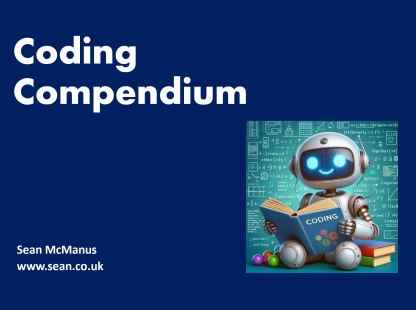
Coding Compendium
A free 100-page ebook collecting my projects and tutorials for Raspberry Pi, micro:bit, Scratch and Python. Simply join my newsletter to download it.
28 June 2014
Do the eyes have it? Sean McManus reports from the UK launch showcase of Google Glass in London
Google has put its wearable technology Google Glass on sale in the UK for the first time, and opened a hands-on showroom in London for two days, where visitors had a chance to try the devices for themselves. I went along and put the glasses to the test.
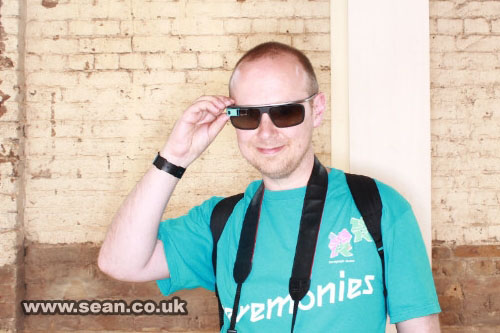
Me trying Google Glass shades, in a colour that matches my top.
Google Glass is a wearable computer. It mounts a tiny screen just above your right eye, which feels similar to viewing a television 8 feet away, a demonstrator said. The screen can show text, maps and images. It includes many of the computing capabilities of a smart phone, including a built-in camera, voice recognition, and GPS for positioning. It is said to have a battery life of a day under normal (intermittent) usage conditions.
It uses Wi-Fi for connectivity and can be tethered to an Android phone or tablet, which would also be used to manage the installation of apps on it. A Wi-Fi connection can be set up by showing the device a QR code, which your phone can generate.
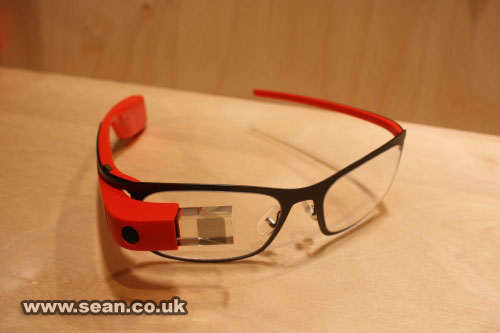
A Google Glass device, with the camera lens and the transparent screen on the left.
There are a couple of different ways of using Google Glass, depending on the context of what you want to do. The right arm of the device (between your ear and your eye) is touch sensitive, and responds to gesture controls. For people who have used tablets, some of these will feel familiar, although they will probably take a little practice to master on the frame. The difference between going backwards and forwards through the timeline, and going back a screen didn't immediately click with me. The main gestures are:
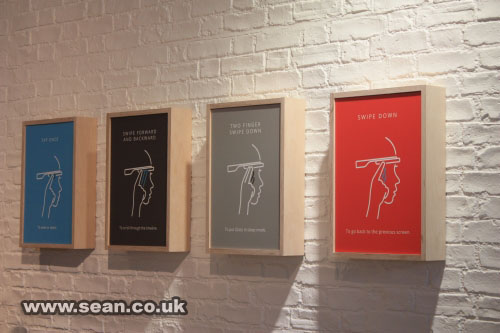
Four posters explain common Google Glass gestures
There are also some non-contact gesture controls. You tilt your head up and down to scroll through menu items, and to look around an image in some of the apps. There's an experimental feature to take a photo by winking at Google Glass, which I tried out. This could be useful for doing quick grab shots of things as a reminder for later, but I'm not sure it would be useful for proper photography.
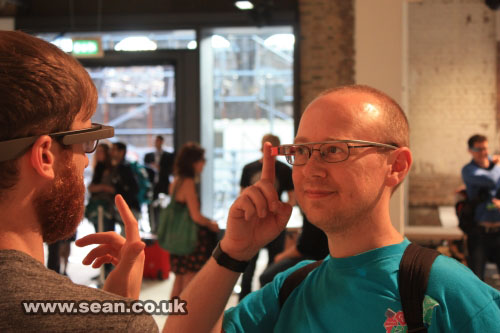
Receiving some instruction on configuring the settings
There were a few different stations set up in the room where you could try different apps on the device. They were:
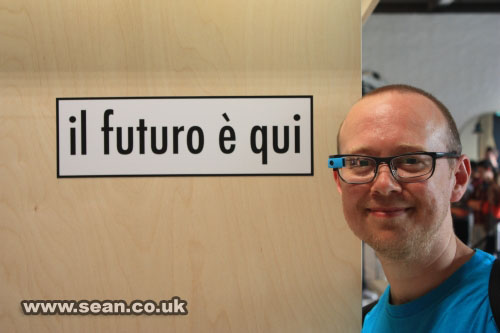
The future is here!
There are other apps available. I spoke to one Googler who'd been using it extensively, and he said the thing he finds most useful are Google Now cards, which provide timely notifications. For example, it'll tell him if he needs to leave early because there are delays on the train, or proactively give him information about today's flight.
The Facebook app is for posting only, and not for consuming information, which seems sensible. Nobody needs to have Facebook on their face all day. The Twitter app enables you to select people whose tweets you'd like to see in your Google Glass. One person I spoke to said that Google Glass is about helping you to live in the moment, and I would imagine that it will be important for apps to be designed in line with that principle, otherwise they will become a permanent distraction.
Naturally, there's some concern in the media about the privacy implications of Google Glass. The Register has described the device as 'creepy', and some people are unsettled by the idea of someone having a lens on their face.
It's quite hard to take a photo discreetly, though, because you have to touch the frame, use a voice command or wink. The video is set to a maximum of 10 seconds by default, and then needs to be extended by interacting with the device. The screen lights up when Glass is active too.
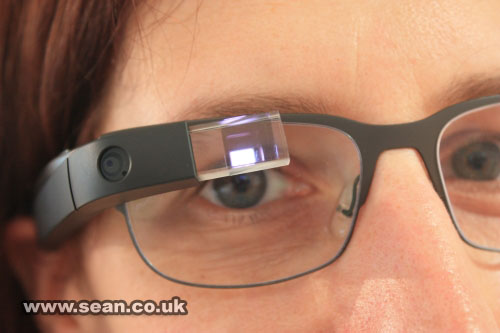
A Google Glass device in use
Nevertheless, as wearable technology is adopted, new norms for usage need to evolve. One person I spoke to said that he'd got into the habit of putting Google Glass on the back of his neck when he goes into the bathroom, to make sure there are no misunderstandings.
Google Glass sits above the eye, so it doesn't block eye contact. You'll have a pretty good idea of when someone's using Glass and when they're paying attention to you.
Google Glass is now available to order in the UK. Although it's not targeted exclusively at developers, it is still an early adopter product at the moment. The software has had 14 releases in 4 weeks, and there's still a lot of testing and iteration going on.
It will be interesting to see how wearable technologies ultimately change the way we interact with information. The killer feature of broadband turned out not to be its speed, but its always-on connectivity, which meant we could ask any question at any time. Similarly, having the internet always available at a voice command, without even having to fumble with a phone, will change how we receive and consume information. The demos shown at the event were fun, but I think the most useful apps will turn out to be those that have the greatest impact on our daily lives: simple notifications, productivity and travel apps. Now Glass is in the UK, app developers here have a chance to shape those apps.
Google has shifted its focus towards enterprise applications for Google Glass, and in 2019 announced the Google Glass Enterprise Edition 2. A focus on the enterprise environment may enable Google to overcome privacy concerns with using Glass in public spaces. It also enables Google to potentially tap into a more lucrative market, and deliver applications with a demonstrable return on investment.
For example, AGCO, a company that carries out custom manufacturing of agricultural machinery, has been able to cut production time by 25% on low-volume complex assemblies, according to AGCO's own analysis. The time saving comes from having checklists, instruction manuals and a camera for quality control available at all times, without assembly engineers having to go back and forth to get what they need. Inspection times have been cut by 30%.
See my blog post with tips on developing Glassware for Google Glass here.
© Sean McManus. All rights reserved.
Visit www.sean.co.uk for free chapters from Sean's coding books (including Mission Python, Scratch Programming in Easy Steps and Coder Academy) and more!

A free 100-page ebook collecting my projects and tutorials for Raspberry Pi, micro:bit, Scratch and Python. Simply join my newsletter to download it.
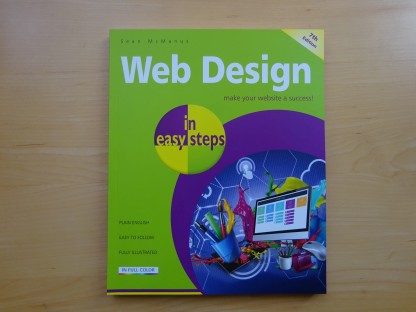
Web Design in Easy Steps, now in its 7th Edition, shows you how to make effective websites that work on any device.
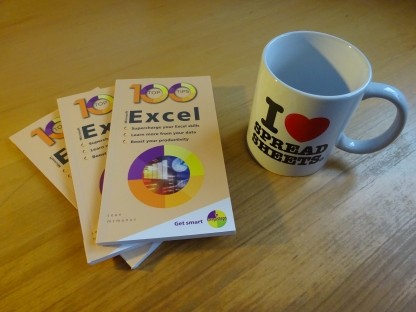
Power up your Microsoft Excel skills with this powerful pocket-sized book of tips that will save you time and help you learn more from your spreadsheets.
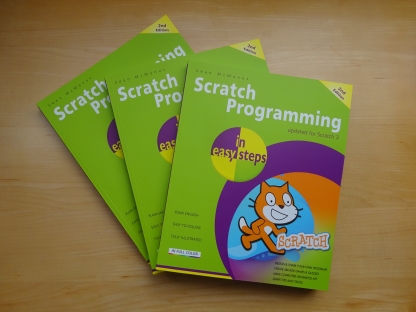
This book, now fully updated for Scratch 3, will take you from the basics of the Scratch language into the depths of its more advanced features. A great way to start programming.
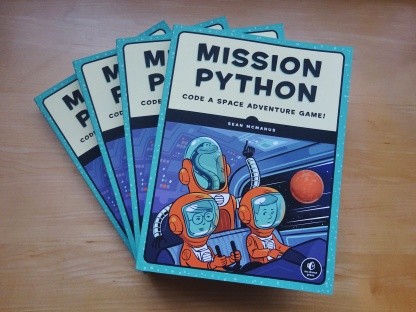
Code a space adventure game in this Python programming book published by No Starch Press.
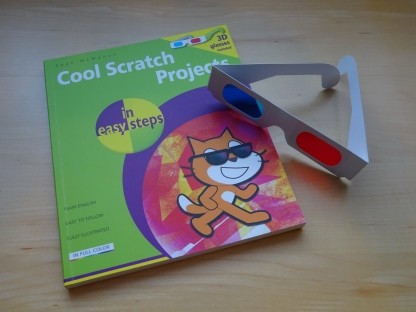
Discover how to make 3D games, create mazes, build a drum machine, make a game with cartoon animals and more!